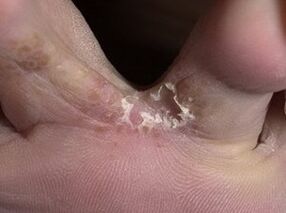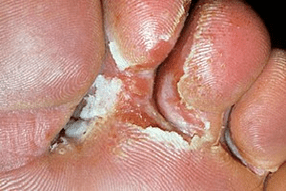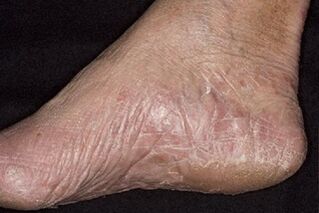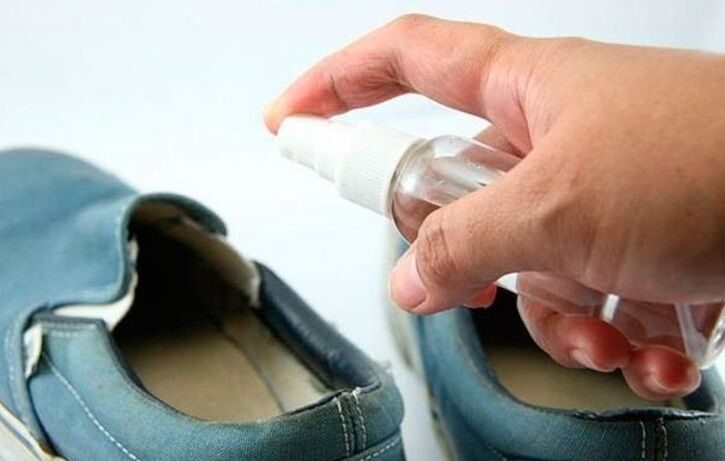Among all fungal diseases, mycoses of the skin of the feet (fungal lesions) are the most common. They are also called ringworm or athlete's foot. About 30% of the population has problems with fungal diseases. Almost half of the patients never go to the doctor and spread the fungus among their relatives. Microscopic pathogens affect the dermis (skin) or nails. In the latter case, they speak of onychomycosis.
Why are the feet most often affected?
There are always various fungi on the skin. Their reproduction is limited by beneficial bacteria and skin secretions. When there are disturbances in the work of immunity, there are changes in the composition of skin microflora, there is a favorable time for fungi - they can reproduce freely. Gateways to infection can serve as regular damage:
- scratches;
- cracks;
- friction.
Another cause of mycoses is endocrine disorders. When there are malfunctions in the endocrine glands, not only the balance of hormones, but also the work of the whole body changes. In addition, the composition of skin secretions changes, so they lose their bactericidal properties. Fungi can feed on them, which promotes reproduction.
Other factors also contribute to the weakening of protective forces:
- alimentary depletion (nutrition);
- avitaminosis;
- excessive physical and psycho-emotional stress;
- tremors;
- regular stress.
All these are non-specific causes of fungal skin lesions. Due to them, mycosis of the feet, smooth skin on the body or mucous membranes can develop.
In addition, there are special types of fungi (genus Trichophyton or Microsporum) - pathogenic (pathogenic). They cause disease when they come into contact with the skin or its surface. In the case of the feet, the disease is called rubromycosis. In the body, these pathogens form special spots - lichen. You can get infected from a person or an animal.
The skin of the feet is a special place for fungi. There are always many keratinized cells. Microbes are used as habitat and food. "Rampant" mushroom helps the feet to sweat. In closed shoes, a moist environment rich in nutrients is formed on the feet - the "dream" of every fungus. If a person ignores foot hygiene, does not dry and disinfect shoes, the infection first multiplies inside him, and then passes to the "owner's" foot. Poor hygiene products, dryness, synthetic socks also contribute to the spread of fungal infection.
Visually noticeable signs of a fungus
Treatment of dermatomycosis is easier, the sooner the disease is diagnosed. In advanced cases, therapy is long-term, involves taking pills and using external agents. In the initial stages of mycosis, ointments can be abandoned. It is important to be able to recognize the first signs of fungus in order to consult a doctor in time.
How the fungus looks depends on the form of mycosis. Fungal infection of the feet can occur in 3 different variations, as well as in a mixed form - when there are symptoms of three main types on the feet at the same time.
Intertriginous form

A type of tinea pedis that mainly affects the skin between the toes. The first sign of the disease is the appearance of a painful crack between the 3rd and 4th or 4th and 5th rings of the foot. The damage is small, but it causes discomfort when washing the feet and walking.
If you carefully examine the wound, you will notice a whitish fringe around it (example in the photo). This is how the edges of the skin look around the peeled crack. The wound itches, oozes, can grow, or vice versa - periodically heals, then reappears.
In some cases, the crack heals, but the skin continues to shed, hyperkeratosis (thickening of the dermis) develops, and corns and calluses appear. With an advanced intertriginous form, cracks grow (example in the photo), appear between other fingers, the skin is constantly moist. It is difficult for the patient to move, wear any shoes.

As this form progresses, the crack size increases. Similar symptoms appear on the second leg. Thick and large layers of skin around the wound wear away. The second (added) end is not rejected, and attempts to remove the keratinized part with the fingers result in additional damage to the foot.
This type of foot fungus is the most common. The manifestation of pathology is not accompanied by any symptoms at first. As a rule, the infection develops between the 3rd and 4th toes and does not change the color and texture of the skin until a certain point. After that, wet cracks and layers appear on the skin.
The foot itself remains harmless, but if the fungus is affected, the feet may sweat more than usual. Fungal treatment of the intertriginous form is characterized by moderate complexity.
Dyshidrotic form

The first signs of a fungus on the skin with this form are blisters on the arch of the foot. Most often - near the heel. The surface dries up, deep seals appear on it (they feel like knots). Then, because they are filled with fluid, they rise noticeably above the level of the skin. Vesicles (vesicles) are usually small - from 2 to 5 mm in diameter. They can unite and form larger ones - bullae. Other symptoms include pain and itching around the rash.
The progression of the dyshidrotic form of mycosis is manifested by the bursting of blisters. Small or large erosions are formed in their place. Often they become infected with bacteria and start to boil. Erosions do not heal for a long time and make walking painful. In some cases, erosion disappears, and dryness appears in their place.
squamous form

As the disease progresses, severe hyperkeratosis develops on the legs. The size and number of cracks increases. The biggest ones can bleed. Such damage is a way for other pathogenic microbes to enter the body. Therefore, the wounds occasionally become inflamed, may become abscesses. The most common form of foot fungus is manifested by increased dryness of the skin on the plantar part of the limb. This means that fungi have recently entered, or vice versa - it can be the result of the development of other forms.
In the arch and center of the foot, the dermis dries up, becomes thin, shiny, and covered with furrows. In the area of the fingers and heels, hyperkeratosis is observed - rapid keratinization, where dead particles do not have time to wear off. Calluses or corns form on the front of the foot. There are small cracks on the soles. The entire surface is rough due to clear crusting. The patient may feel itching. With the long-term development of mycosis, this symptom is absent.
Fungus on the legs can be identified by excessive dryness, unpleasant odor, itching and constant peeling of the skin.
Onychomycosis
Onychomycosis is a type of foot (or palm) fungus that affects the appendages of the skin - the nails. Nail fungus can be caused by the same pathogens that cause skin mycosis. Get infected with mold and other types of mono fungus in the manicure room, at the beach, when wearing new shoes on your bare feet, going to the sauna or swimming pool. Can cause ingrown toenails. The thumb is most commonly affected.
When it hits the nail plate, the fungus begins to divide. It penetrates deeply into the nails and spreads over its area. The first signs by which you can determine the fungus on the nails are the loss of shine, the appearance of spots (white, yellow, brown, greenish), a change in the shape of the nail plate.
As the disease progresses, the nail structure changes in the discoloration zone (thickens, bumps, loosens).
Toenail fungus looks like thick yellow growths. Affected nail plates are difficult to care for. You should do warm foot baths before each cut. After contact with water, nails become softer and easier to remove with manicure tools.
If the nail fungus is not treated, onycholysis begins - the plate completely or partially erodes. After removing its remains, the nail does not always grow back. Sometimes the separation process ends with the complete loss of nails.
General principles of treatment

Fungus on the feet is treated with ointments, creams, solutions, and special varnishes. In parallel, the patient is prescribed antifungal tablets.
During the entire period of treatment, careful foot hygiene, weekly trimming and trimming of the affected part are indicated. Every day, the patient should remove the layer of keratinized cells from the surface of the feet using a pedicure file.
It is also important to carefully care for shoes - treat them with antifungal drugs or disinfectants. Shoes are air-dried and aired daily.
External means
In the initial stages of foot fungus, only ointment or cream is prescribed. Cream and other drugs are prescribed for treatment. It is applied to the skin 1-2 times a day, after washing the feet thoroughly with simple soap. It is important to dry the feet completely before using creams. Do not apply the medicine to wet skin. After the treatment, the patient should wear cotton socks.
Tablets
It is impossible to treat fungus independently with pills. All drugs have a negative effect on the functioning of the liver and kidneys, and have a number of contraindications. Before prescribing a course of antifungal tablets, the specialist will recommend conducting a general and biochemical blood test, which can be used to assess the condition of vital organs.
Preparations for nails
Useful in the treatment of onychomycosis and athlete's foot. In the first case, they are used to remove the affected part of the nail, and in the second - to prevent fungal infection of the nail plates.
It is most convenient to treat with varnishes - applied to the nails 1-2 times a week. The most convenient drugs for nail fungus are solutions, which are applied to the nails 2 times a day until complete recovery. Special gels are popular. They visually improve the condition of the affected nails, stop the growth of fungi along the way. Ointments are also prescribed for onychomycosis. They are applied to the affected plates in a thick layer, covered with a bandage, kept until the product is completely absorbed. The treatment is repeated twice a day.
Preventing athlete's foot is easier than treating it. For this, you should lead a healthy lifestyle, take your own slippers to the pool and sauna, wash and air your shoes regularly, wear socks made of natural fabric, and use antiperspirants. With regular visits to "wet" establishments, you should use antifungal creams as a preventive measure - treat the skin of the feet 1-2 times a week.
















